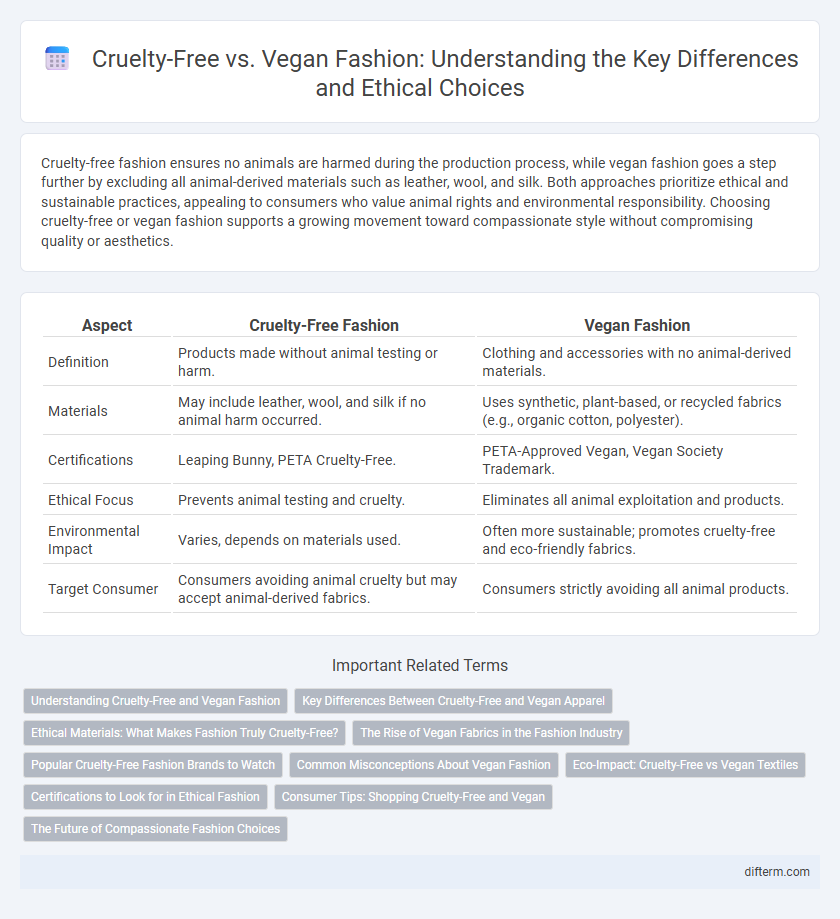Cruelty-free fashion ensures no animals are harmed during the production process, while vegan fashion goes a step further by excluding all animal-derived materials such as leather, wool, and silk. Both approaches prioritize ethical and sustainable practices, appealing to consumers who value animal rights and environmental responsibility. Choosing cruelty-free or vegan fashion supports a growing movement toward compassionate style without compromising quality or aesthetics.
Table of Comparison
| Aspect | Cruelty-Free Fashion | Vegan Fashion |
|---|---|---|
| Definition | Products made without animal testing or harm. | Clothing and accessories with no animal-derived materials. |
| Materials | May include leather, wool, and silk if no animal harm occurred. | Uses synthetic, plant-based, or recycled fabrics (e.g., organic cotton, polyester). |
| Certifications | Leaping Bunny, PETA Cruelty-Free. | PETA-Approved Vegan, Vegan Society Trademark. |
| Ethical Focus | Prevents animal testing and cruelty. | Eliminates all animal exploitation and products. |
| Environmental Impact | Varies, depends on materials used. | Often more sustainable; promotes cruelty-free and eco-friendly fabrics. |
| Target Consumer | Consumers avoiding animal cruelty but may accept animal-derived fabrics. | Consumers strictly avoiding all animal products. |
Understanding Cruelty-Free and Vegan Fashion
Cruelty-free fashion emphasizes products made without animal testing or harm during production, ensuring ethical treatment of animals throughout the supply chain. Vegan fashion strictly excludes all animal-derived materials such as leather, wool, silk, and fur, prioritizing plant-based or synthetic alternatives. Both approaches promote sustainable and ethical practices, appealing to environmentally conscious consumers who value animal welfare and ecological preservation.
Key Differences Between Cruelty-Free and Vegan Apparel
Cruelty-free apparel ensures no animals were harmed or tested on during product development, while vegan fashion excludes all animal-derived materials such as leather, wool, and silk. Vegan clothing often uses plant-based or synthetic alternatives like organic cotton, polyurethane, and recycled fibers, whereas cruelty-free items may still contain animal materials if sourced ethically. The primary distinction lies in vegan fashion's strict avoidance of animal products, compared to cruelty-free's emphasis on animal welfare and ethical testing standards.
Ethical Materials: What Makes Fashion Truly Cruelty-Free?
Ethical materials in cruelty-free fashion exclude animal-derived substances such as leather, wool, and silk, favoring alternatives like organic cotton, recycled polyester, and plant-based fabrics. True cruelty-free fashion ensures no harm to animals throughout production, aligning with standards set by organizations like PETA and The Vegan Society. The adoption of innovative materials like Pinatex and mushroom leather reflects the growing commitment to sustainable, animal-friendly alternatives in the fashion industry.
The Rise of Vegan Fabrics in the Fashion Industry
Vegan fabrics such as organic cotton, pineapple leather, and mushroom mycelium have surged in popularity, marking a significant shift in the fashion industry's approach to sustainability and ethics. These innovative materials eliminate the use of animal-derived components, aligning closely with vegan fashion principles while addressing consumer demand for cruelty-free clothing. The rise of vegan fabrics supports a growing market trend toward eco-conscious apparel that reduces environmental impact without compromising style or durability.
Popular Cruelty-Free Fashion Brands to Watch
Popular cruelty-free fashion brands to watch include Stella McCartney, known for using sustainable materials without animal products, and Matt & Nat, specializing in vegan handbags made from recycled materials. Beyond Skin offers stylish cruelty-free shoes crafted from plant-based leathers, while Vaute Couture merges ethical practices with innovative vegan outerwear. These brands emphasize transparency, sustainable sourcing, and animal welfare, leading the movement in cruelty-free and vegan fashion.
Common Misconceptions About Vegan Fashion
Many people mistakenly believe vegan fashion strictly excludes all animal products, but it primarily avoids leather, wool, silk, and fur while sometimes allowing materials like beeswax or shellac. Another common misconception is that vegan fashion is always synonymous with cruelty-free, although cruelty-free emphasizes ethical treatment of animals during production, not solely the absence of animal-derived materials. Consumers should understand that vegan fashion can incorporate innovative synthetic and plant-based materials such as pineapple leather and mushroom mycelium to create sustainable, animal-free garments.
Eco-Impact: Cruelty-Free vs Vegan Textiles
Cruelty-free fashion prioritizes the avoidance of animal testing and harm but may still use animal-derived materials, whereas vegan fashion excludes all animal products entirely, favoring plant-based or synthetic textiles. Vegan textiles, such as organic cotton, hemp, and recycled polyester, often have a lower environmental footprint by reducing reliance on livestock, which contributes significantly to greenhouse gas emissions and resource depletion. Choosing vegan textiles supports sustainable practices by minimizing water usage and chemical inputs, enhancing the overall eco-impact compared to some cruelty-free options that incorporate animal-based fibers.
Certifications to Look for in Ethical Fashion
When evaluating cruelty-free vs vegan fashion, key certifications to seek include PETA-Approved Vegan, ensuring no animal-derived materials, and the Global Organic Textile Standard (GOTS), which verifies organic and sustainable fabric production. The Responsible Wool Standard (RWS) certifies ethical treatment of sheep, while the Leather Working Group (LWG) focuses on sustainable leather practices, bridging the gap between cruelty-free and vegan categories. These certifications provide transparency and accountability, guiding consumers towards genuinely ethical fashion choices.
Consumer Tips: Shopping Cruelty-Free and Vegan
Consumers seeking cruelty-free and vegan fashion should prioritize brands certified by organizations like PETA or The Vegan Society to ensure genuine ethical practices. Opt for materials such as organic cotton, recycled polyester, or plant-based alternatives like Pinatex that avoid animal exploitation and reduce environmental impact. Transparency in sourcing and production, alongside customer reviews, can guide informed purchases aligned with sustainable and animal-friendly values.
The Future of Compassionate Fashion Choices
The future of compassionate fashion centers on the growing demand for cruelty-free and vegan fashion, which prioritizes animal welfare and environmental sustainability. Innovations in plant-based materials and ethical manufacturing processes drive this shift, catering to conscientious consumers seeking transparency and responsibility. Brands investing in cruelty-free certifications and vegan textiles are shaping a more humane and eco-friendly industry landscape.
Cruelty-free vs vegan fashion Infographic

 difterm.com
difterm.com